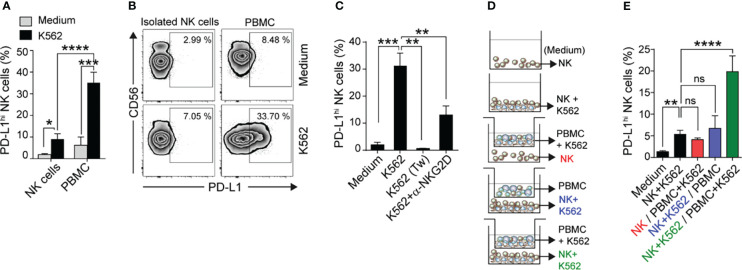Figure 3.
Emergence of PD-L1hi NK cells requires contact with tumor cells and PBMC-derived soluble factors. (A) Frequency of PD-L1hi NK cells after culture of isolated NK cells or PBMC in the absence (Medium) or in the presence of K562 cells for 48 h, assessed by flow cytometry (n=7-11). (B) Representative zebra plots. (C) Frequency of PD-L1hi NK cells after culture of PBMC in the absence (Medium) or in the presence of K562 cells, in contact or separated by a Tw, or in the presence of anti-NKG2D blocking mAb for 48 h, assessed by flow cytometry (n=4). (D) Experimental design used to assess the requirements for the induction of PD-L1hi NK cells. Isolated NK cells, PBMC and K562 cells were cultured separated by Tw as indicated in the figure. (E) Frequency of PD-L1hi NK cells after culture of isolated NK cells in the absence (Medium) or in the presence of K562 cells or PBMC together or separated by Tw, assessed by flow cytometry (n=3). Data represent mean ± SEM. Two-way ANOVA with Sidak´s multiple comparison (A) and one-way ANOVA with Dunnett´s (C) and Tukey´s (E) posthoc. ns, non-significant; *p<0.05, **p<0.01, ***p<0.001, ****p<0.0001.

